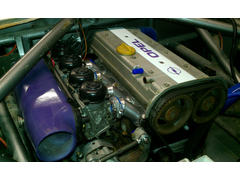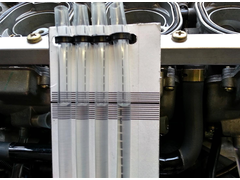
how do you choose the right carb float height?
blakep82 - 25/12/13 at 03:52 PM
not very christmassy this (hope you're all having a good one) but i've already been out to the garage, and i'm going back out again
soon 
engine was running very fast and very hot, so after a bit of work with pilot air screws things are running a bit better, slower, and cooler
still leaking a load of petrol though! carbs are ZX9R E spec carbs, and they usually sit at an angle on the bike, but on my car they have to sit
horizontal, so i expect the valves need to close sooner, but how much sooner? ie how to i decide when i need them to close on my car?
once i understand these carbs better, i'll be sorted! but for now, i'm hugely confused with the whole thing... i still can't understand
why screwing in the pilot screws and leaning out the mix makes it idle so fast while the butterflies are all closed, but i'll get it one day
Angled is not an option


Description
[Edited on 25/12/13 by blakep82]
davidimurray - 25/12/13 at 04:35 PM
The floats need to be shut before the fuel level reaches the outlet inside the body of the carb. I would imagine that the setting recommended by
Kawasaki would be fine as long as the fuel does not come out of the main jet. Easiest method is to check it with the clear tube method.
I am using zx6r carbs so if I can be any help just shout.
doddy - 25/12/13 at 05:45 PM
i would say you need to make then sit at the angle that they sit on the bike to stop them overflowing
teegray19 - 25/12/13 at 07:44 PM
Your carb bowl angle is miles out, the cast casting on the side of the carb has to be parrallel to the floor otherwise you will have huge fueling
probs.
r1_pete - 25/12/13 at 08:17 PM
The float height controls how far up the jet tube the fuel level is, having a big impact on mixture.
I would try working out where that is with the carbs angled as they were on the bike, i.e. the float chamber face horizontal, then adjust the float so
you have the same level relative to the jet tube in your layout.
Bike carbs seem to work at many angles, I used to wheelie my R1 for long distances and it never missed a beat, certainlt far fewer than the bottom
steering bearings I knocked out...



davidimurray - 25/12/13 at 08:30 PM
Lots of people say angle is critical - but I've never seen a technical explanation why. This is my take on why I don't think they are
critical.
Firstly think about how the carb works. You have a reservoir, the float bowl, that has its level set by the float valve. This reservoir is enclosed,
but has a connection to atmosphere and a connection to the inlet tract via the jets. As air passes the throttle/slide you get a low pressure that
sucks the fuel out of the bowl, into the inlet tract. The amount of fuel is controlled by the particular circuit that is being called upon at that
time. The important criteria here is the distance between the fuel level in the float bowl and the top of the outlet into the inlet tract. Now as you
rotate the carb around its centre point, the effective distance between fuel level and nozzle tip changes only by a small amount but what you do is
change the amount of fuel that is in the float bowl- but the relationship between fuel level and outlet to the inlet tract remains similar.
It is for this reason that bikes can go up/down hills and wheelie. If the float level was that critcal then bikes wouldnt be able to go up/down
hills.
Hence I believe that as long as you don't rotate the carbs so far that you end up with a float bowl that holds no fuel you should be fine.
[Edited on 25/12/13 by davidimurray]
blakep82 - 25/12/13 at 08:30 PM
quote:
Originally posted by teegray19
Your carb bowl angle is miles out, the cast casting on the side of the carb has to be parrallel to the floor otherwise you will have huge fueling
probs.
no one seems to have told Bogg Brothers this! 


Thank you David for the u2u, and thank you pete, like you said they're made to work at all sorts of angles, so should be fine how they are. maybe
not ideal, but what else can i do? its tight for space. maybe need to strip them down again, clean them properly, and work out the best float height.
i've got them set sort of minimal at the minute, if its good enough to idle nicely, that'll do me for now. can always change it later, what
i can't work out though, is how much of the float sits IN the fuel (below the level) it seems to be one of these things where you can't
really see whats going on, but have to take a guess. though David sis give me a tip on using clear pipe attached tot he drain screws at the bottom to
check where the level is, so will give that a shot
[Edited on 25/12/13 by blakep82]
davidimurray - 25/12/13 at 08:36 PM
Blake, this might help explain the clear tube method.

whitestu - 25/12/13 at 11:09 PM
My ZX6 carbs have been running horizontal for the past 4 years. The angle makes no difference to how well they work.
Stu
40inches - 26/12/13 at 03:22 PM
Float level is easy to check, not so much if it needs adjusting.
I knocked up a tool to check the levels of all the carbs at once.


Description
PM your address and I will send it for you to borrow.
baz-R - 28/12/13 at 10:19 AM
you can get bike carbs that are designed to run at all sorts of angles. thay are no diffrent to any other carb you have to fit them in the angle thay
where designed
you dont take a down draft car carb and fit it to a side draft manifold do you so why do people think bike carbs are any diffrent?
usualy jap bike carbs have 1 or 2 line cast into the side of the body or bowl with fuel hight on to make life easy and we can use the lines to work
out what angle thay are normaly fitted
davidimurray - 29/12/13 at 10:32 AM
quote:
Originally posted by baz-R
you can get bike carbs that are designed to run at all sorts of angles. thay are no diffrent to any other carb you have to fit them in the angle thay
where designed
you dont take a down draft car carb and fit it to a side draft manifold do you so why do people think bike carbs are any diffrent?
usualy jap bike carbs have 1 or 2 line cast into the side of the body or bowl with fuel hight on to make life easy and we can use the lines to work
out what angle thay are normaly fitted
Why do they have to be fitted at the angle in the bike? I would be interested to know why this is as I cannot understand why.
Taking a down draft and using it turned 90 degrees is rather an extreme example. If you take any carb - side,draft, bike they all work at a range of
angles otherwise they wouldn't be able to up/down hills and on cambers.
The air sucks the fuel from the bowl through the jets. The head that is required to suck this fuel is based on the distance between the inlet tract
and the top of the fuel in the bowl. As long as the jets are mounted near the centre of the bowl, as you rotate the carb the distance between the bowl
fuel level and inlet tract remains virtually unchanged. Looking at a few common carbs, the pilot and main jets are on the same line so they should
both be 'effected' in the same way. There will be a point at either end of the extreme angles where gravity no longer comes into play, the
floats don't work etc. How Both Bros get them to work vertically is a mystery.....
baz-R - 29/12/13 at 12:11 PM
quote:
Originally posted by davidimurray
quote:
Originally posted by baz-R
you can get bike carbs that are designed to run at all sorts of angles. thay are no diffrent to any other carb you have to fit them in the angle thay
where designed
you dont take a down draft car carb and fit it to a side draft manifold do you so why do people think bike carbs are any diffrent?
usualy jap bike carbs have 1 or 2 line cast into the side of the body or bowl with fuel hight on to make life easy and we can use the lines to work
out what angle thay are normaly fitted
Why do they have to be fitted at the angle in the bike? I would be interested to know why this is as I cannot understand why.
Taking a down draft and using it turned 90 degrees is rather an extreme example. If you take any carb - side,draft, bike they all work at a range of
angles otherwise they wouldn't be able to up/down hills and on cambers.
The air sucks the fuel from the bowl through the jets. The head that is required to suck this fuel is based on the distance between the inlet tract
and the top of the fuel in the bowl. As long as the jets are mounted near the centre of the bowl, as you rotate the carb the distance between the bowl
fuel level and inlet tract remains virtually unchanged. Looking at a few common carbs, the pilot and main jets are on the same line so they should
both be 'effected' in the same way. There will be a point at either end of the extreme angles where gravity no longer comes into play, the
floats don't work etc. How Both Bros get them to work vertically is a mystery.....
sadly its not quiet as simple as that what about all the other bits and bobs in a modern bike carb like throttle pumps,idle circuits,emulsion tubes
air jets, overflow ports and so on not to mention pivot angle of the float its self
yes you can go a few degrees but you cant go too far.
also i dont think i have ever seen a bike carb conversion that has the nice fueling everywhere thats why i fitted my own fuel injection setup with a
mix of bike bodies and car injection parts and a self mapped ecu (1.8 zetec 165.1bhp @ 7100)
i have worked on tons of bike carbs and you can get them at almost any angle anywhere from straight down to horizontal so maybe bog bros do fit them
at the angle thay where designed to run in the bike thay came from?
take the v4 honda i had it had a diffrent carb design for each bank of cyl as thay wher fitted at diffrent angles and each had its float and related
parts set to work leval with the jet/emulsion tube holders and float pivots all set vertical and i think honda know a thing or 2 about carbs now.
thinking about it the only carb i know thats fitted at a number of angles with the same design is a old su carb but its very basic, you had the float
on the side and you ajusted the angle of it to suit and it had no throttle pump or idle circuit










